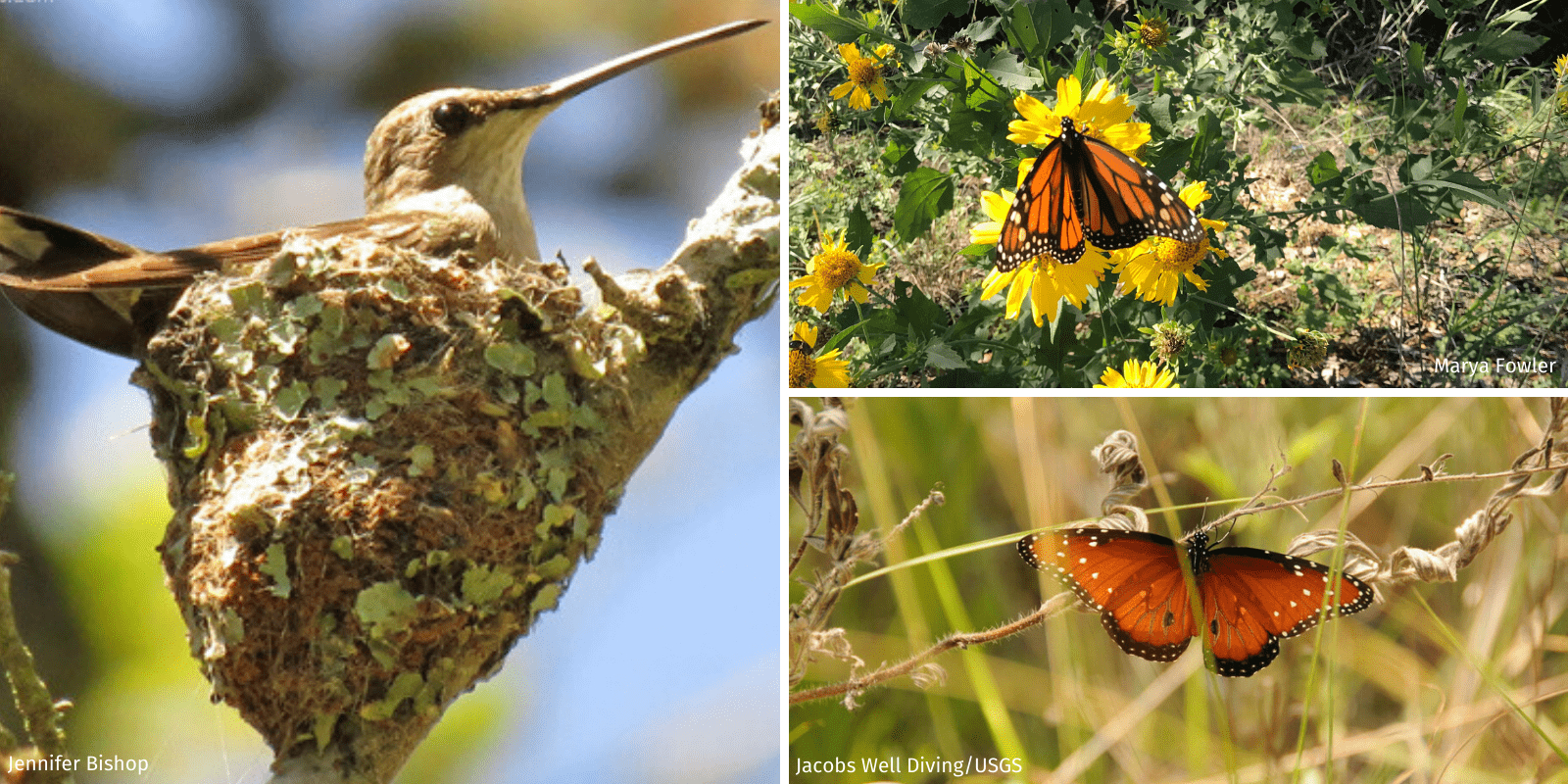We have much more to do and your continued support is needed now more than ever.
Virtually Migrate through Texas with Pollinators

Every spring and fall, hundreds of species migrate through Texas – many of which are pollinators such as birds and butterflies. Pollinators are organisms that move pollen from one flower to another while feeding on plants. Do you know which pollinators migrate through your community and how to attract them to your porch, your yard, or your school?
Citizen scientists have been helping researchers to track several different species through annual spring and fall migration events and with crowd-sourcing tools such as iNaturalist and Journey North. To increase your chances of spotting a migratory pollinator, you can build a habitat garden that provides for their needs: food, water, shelter, and a place to raise young. Follow along with us to three schools in Central Texas who have been creating habitat gardens for pollinators.
Monarch Butterflies: Fisher Elementary in San Antonio, Texas
Monarch butterflies require native nectar plants for food to fuel their journey – which can be up to 3,000 miles long during their fall migration. They also require native milkweed to raise their young—as milkweed is the only host plant for this species’ larval stage. Students at Fisher Elementary are participating in the National Wildlife Federation’s Monarch Heroes Program, where they have taken up the mission to provide habitat for the monarch butterfly and other pollinators.
The students planted a garden in a courtyard with a great mix of native plants and milkweed to provide a rest stop for migrating butterflies on their annual trip. They also planted native shrubs for shelter and put in small dishes filled with water and rocks to mimic natural puddling areas – muddy or sandy patches where butterflies land to drink water for hydration and nutrients. They have now seen monarchs and many other pollinators in their gardens!

Hummingbirds: Kuentz Elementary in Helotes, Texas
Hummingbirds use memory to return to spots with exceptionally good food sources and they love native, tube-shaped flowers that are perfect for their thin, long beaks to reach nectar. They build small nests in trees to raise their young. Although most hummingbirds do not breed in Central Texas, sources of water and nectar are still crucial for them on their way to breeding grounds in the Eastern and Western United States.

Kuentz Elementary in Helotes, TX has created a beautiful sanctuary for monarch butterflies through the Monarch Heroes Program and is now working to increase biodiversity by adding new native plants to attract hummingbirds and other pollinators on their journeys. They are also working with partner organizations EcoRise and Project ACORN to provide additional shelter for other migratory bird species that do often nest here, such as purple martins!
Gulf Fritillary and Queen Butterflies: Winn Elementary, Austin, TX
Gulf fritillary and queen butterflies are sometimes mistaken for monarch butterflies because they are also orange with black features. After seeing butterflies in their garden using nectar plants for food, Winn Elementary in Austin, TX learned about the host plants these species needed to raise their young. The Winn team then planted additional milkweed (for the queens and monarchs) and passion vine (for the Gulf fritillary) in their Monarch Heroes garden. Since planting, the school has seen caterpillars for all three butterflies! They have also seen many other pollinators enjoying their water feature and enjoying the shelter of their pocket prairie.

These schools received Monarch Heroes garden grants from National Wildlife Federation to increase biodiversity, or the number of different species present, on their school campuses. They have all seen an increase in biodiversity and have created a nice place for humans to learn and observe nature, too!
If you’d like to learn how to increase biodiversity at home or at your school, the first step is to observe which insects and animals are currently visiting the area. Then, compare this to what you see at local natural places. What kinds of plants and features do you see in these natural spaces? What could you replicate at home to encourage migratory pollinators to visit you wherever you are? Start today by following us on YouTube for a virtual field trip video series!
Most importantly, research the species you would like to attract through resources like the National Wildlife Federation nature guides. Then, create a plan make sure you include their needs in your garden design using the book Attracting Birds, Butterflies, and Other Backyard Wildlife by National Wildlife Federation Naturalist, David Mizejewski, or other resources in the library or online. Once you have provided for the needs of these species—food, water, shelter, and places to raise young—apply for your new habitat to be distinguished as a National Wildlife Federation Certified Wildlife Habitat or Schoolyard Habitat!
About the program: Created in 2015, the Monarch Heroes program has now provided grant funds to help create pollinator gardens on 150 campuses and training for over 450 teachers in the cities of Austin, Dallas, Georgetown, Houston, and San Antonio. In 2020, the program will expand into Fort Worth.
—





















